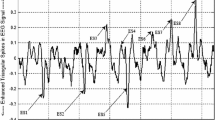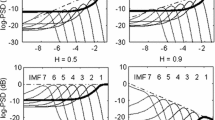Abstract
In this paper, we used the Hilbert-Huang transform (HHT) analysis method to examine the time-frequency characteristics of spike waves for detecting epilepsy symptoms. We obtained a sample of spike waves and nonspike waves for HHT decomposition by using numerous intrinsic mode functions (IMFs) of the Hilbert transform (HT) to determine the instantaneous, marginal, and Hilbert energy spectra. The Pearson correlation coefficients of the IMFs, and energy-IMF distributions for the electroencephalogram (EEG) signal without spike waves, Spike I, Spike II and Spike III sample waves were determined. The analysis results showed that the ratios of the referred wave and Spike III wave to the referred total energy for IMF1, IMF2, and the residual function exceeded 10 %. Furthermore, the energy ratios for IMF1, IMF2, IMF3 and the residual function of Spike I, Spike II to their total energy exceeded 10 %. The Pearson correlation coefficients of the IMF3 of the EEG signal without spike waves and Spike I wave, EEG signal without spike waves and Spike II wave, EEG signal without spike waves and Spike III wave, Spike I and II waves, Spike I and III waves, and Spike II and III waves were 0.002, 0.06, 0.01, 0.17, 0.03, and 0.3, respectively. The energy ratios of IMF3 in the δ band to its referred total energy for the EEG signal without spike waves, and of the Spike I, II, and III waves were 4.72, 6.75, 5.41, and 5.55 %, respectively. The weighted average frequency of the IMF1, IMF2, and IMF3 of the EEG signal without spike waves was lower than that of the IMF1, IMF2, and IMF3 of the spike waves, respectively. The weighted average magnitude of the IMF3, IMF4, and IMF5 of the EEG signal without spike waves was lower than that of the IMF1, IMF2, and IMF3 of spike waves, respectively.











Similar content being viewed by others
References
Subha, D. P., Joseph, P. K., Acharya, R., et al., EEG Signal Analysis: A Survey. J Med Syst 34:195–212, 2010.
Jasmin, K., and Abdulhamit, S., The Effect of Multiscale PCA De-noising in Epileptic Seizure Detection. J Med Syst 38:131, 2014.
Orhan, U., Hekim, M., and Ozer, M., Epileptic Seizure Detection Using Probability Distribution Based On Equal Frequency Discretization. J Med Syst 36:2219–2224, 2012.
Akin, Comparison of Wavelet Transform and FFT Methods in the Analysis of EEG Signals. J Med Syst 26:241–247, 2012.
Sumathi, S., Beaulah, H. L., and Vanithamani, R., A Wavelet Transform Based Feature Extraction and Classification of Cardiac Disorder. J Med Syst 38:98, 2014.
Francis, S. V., Sasikala, M., and Saranya, S., Detection of Breast Abnormality from Thermograms Using Curvelet Transform Based Feature Extraction. J Med Syst 38:23, 2014.
Abeles, M., and Goldstein, M. H., Multispike train analysis. Proceedings of the IEEE 65:762–776, 1977.
Michael, S. L., A review of methods for spike sorting: the detection and classification of neural action potentials. Comput. Neural Syst 9:R53–R78, 1998.
Fabrizio, G., and Christof, K., Principles of spike train analysis. In: Christof, K., and Idan, S. (Eds.), Method in Neuronal Modeling, 2nd edition. Massachusetts Tnstitude of Technology, USA, pp. 313–360, 1999.
Harris, K. D., Dareewll, A., Henze, J. C., et al., Accuracy of tetrode spike separation as Determined by simultaneous intracellular and extracellular measurements. J Neurophysiol 84:401–414, 2000.
Hill DN, Kleinfeld D, Mehta SB (2007) Spike sorting. In: Mitra PP, Bokil H (ed) Observed Brain Dynamics, Oxford Press, pp.257–270.
Huang, N. E., and Hen, S. S. P., Hilbert-Huang Transform and its Applications. World Scientific Publishing Co., Singapore, pp. 1–307, 2005.
Huang, N. E., Shen, Z., Long, S. R., et al., The empirical mode decomposition and the Hilbert spectrum for non-linear and non-stationary time series analysis. Proceedings of the Royal Society of London Series A—Mathematical Physical and. Engineering Sciences 454:903–995, 1998.
Wu, M. C., and Huang, N. E., The Bimedical Data Processing Using HHT: A Review. In: Nait-Ali, A. (Ed.), Advanced Biosignal Processing. Springer Publishers, Berlin Heidelberg, pp. 335–35, 2009.
Yan, R., and Gao, R. T., A tour of the Hilbert-Huang transform: an empirical tool for signal analysis. IEEE Instrumentation & Measurement Magazine 10:11–15, 2007.
Pigorini, A., Casali, A. G., Casarotto, S., et al., Time-frequency spectral analysis of TMS-evoked EEG oscillations by means of Hilbert-Huang transform. Journal of Neuroscience Methods 19:236–245, 2011.
Şen, B., Peker, M., Çavuşoğlu, A., et al., A Comparative Study on Classification of Sleep Stage Based on EEG Signals Using Feature Selection and Classification Algorithms. J Med Syst 38:18, 2014.
Deng, S., Srinivasan, R., Lappas, T., et al., EEG classification of imagined syllable rhythm using Hilbert spectrum methods. Journal of Neural Engineering 7:046006, 2010.
Nonclercq, A., and Mathys, P., Quantification of Motion Artifact Rejection Due to Active Electrodes and Driven-Right-Leg Circuit in Spike Detection Algorithms. IEEE Transactions on Biomedical Engineering 57:2746–2752, 2010.
Piotr, D., Adaptive time-frequency parametrization of epileptic EEG spikes. Phys Rev E Stat Nonlin Soft Matter Phys 69:051914, 2004.
Piotr, D., Matching Pursuit and Unification in EEG Analysis. Aretch House, Boston, pp. 1–184, 2007.
Quiroga, R. Q., Nadasdy, Z., and Shaul, Y. B., Unsupervised Spike Dectection and Sorting with Wavelets and Superparamagnetic Clustering. Neural Computation 16:1661–1587, 2004.
Lin, C. F., and Zhu, J. D., Hilbert-Huang Transformation Based Time-frequency Analysis Methods in Biomedical Signal Applications. Proceedings of the Institution of Mechanical Engineers, Part H, Journal of Engineering in Medicine 226:208–216, 2012.
Lin, C. F., Yeh, S. W., Chang, S. H., et al., An HHT-based Time-frequency Scheme for Analyzing the EEG Signals of Clinical Spikes. Nova, USA, pp. 1–30, 2010.
Lin, C. F., Yang, B. H., Peng, T. I., et al., Sharp Wave Based HHT Time-frequency Features with Transmission Error. In: Georgi, G., and Theo, A. R. (Eds.), Advance in Telemedicine: Technologies, Enabling Factors and Scenarios. Intech Science Publishers, Austria, pp. 149–164, 2011.
Zhu, J. D., and Lin, C. F., Hilbert-Huang Transform based Intrinsic Mode Functions Energy of Spike Wave. Advanced Materials Research 461:411–413, 2012.
Zhu JD, Lin CF (2014) Analyzing Spike I Wave Electroencephalogram Signals for Epilepsy Based on Hilbert-Huang Transformation, IEEE International Symposium on Bioelectronics and Bioinformatics.
Kurth, C., Gilliam, F., and Steinhoff, B. J., EEG Spike Detection With a Kohonen Feature Map. Annals of Biomedical Engineering 28:1362–1369, 2000.
Caporale, N., and Dan, Y., Spike Timing—Dependent Plasticity: A Hebbian Learning Rule. Annu. Rev. Neurosci 31:25–46, 2008.
Tan, C. S., Morris, I., and Wadia, A., Spike-Type Compressor Stall Inception, Detection, and Control. Annu. Rev. Fluid Mech. 42:275–300, 2010.
Yu, B., Mak, T., Li, X., et al., Stream-based Hebbian Eigenfilter for real-time neuronal spike discrimination. BioMedical Engineering OnLine 11:18, 2012.
Ong, K. C. G., Wang, Z., and Maalej, M., Adaptive magnitude spectrum algorithm for Hilbert-Huang transform based frequency identification. Engineering Structures 30:33–41, 2008.
Koh, S. J. A., Maalej, M., and Quek, S. T., Damage quantification of flexurally loaded RC slab using frequency response data. Struct Health Monit 3:293–311, 2004.
Acknowledgments
The authors acknowledge the support of the Center for Marine Bioscience and Biotechnology, National Taiwan Ocean University, and the Chang Cung Memorial Hospital, Keelung Branch Research Project 98529002 K8, and the valuable comments of the reviewers.
Author information
Authors and Affiliations
Corresponding author
Additional information
This article is part of the Topical Collection on Education & Training
Rights and permissions
About this article
Cite this article
Zhu, JD., Lin, CF., Chang, SH. et al. Analysis of spike waves in epilepsy using Hilbert-Huang transform. J Med Syst 39, 170 (2015). https://doi.org/10.1007/s10916-014-0170-6
Received:
Accepted:
Published:
DOI: https://doi.org/10.1007/s10916-014-0170-6




